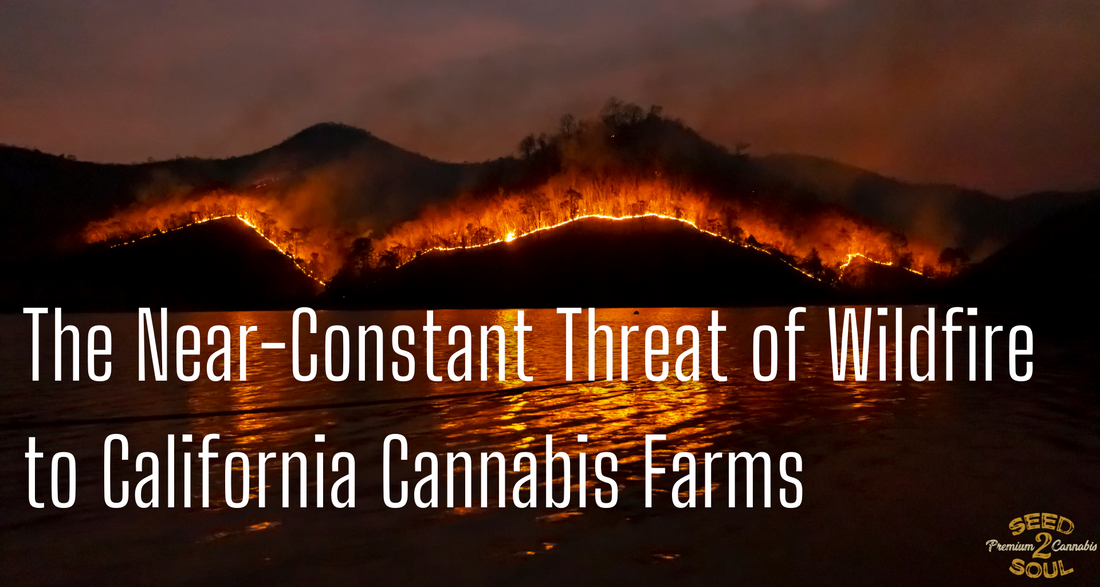
News
The Near-Constant Threat of Wildfire to California Cannabis Farms
The Near-Constant Threat of Wildfire to California Cannabis Farms
California’s Emerald Triangle may seem like a veritable Eden for cannabis cultivation, but starting in the late summer of every year, growers must again endure the whiteknuckle tension of the West Coast’s legendary “fire season.” In 2020, the Golden State lost a devastating 4.2 million acres of land to a particularly furious fire season… but this number rolls into the other millions lost over the previous years as conditions only continue to deteriorate. Further compounded by a harrowing drought and the building inertia of climate change, the season of the wildfire has become a nightmarishly reliable annual event, ominously looming over a region responsible for over a third of the state’s licensed operations for growing cannabis. In a situation that seems to go from bad to worse every year, how much longer can cultivators outrun the flames?
A Perfect Storm? More Like a Perfect Drought
This year’s Monument Fire has already impacted hundreds of cannabis grow sites to varying degrees and we’re just entering a fire season predicted to last through December. With a drought further exacerbating the situation, much of California is a powderkeg just waiting for a stray spark. It wasn’t always like this, but the situation has been steadily progressing for decades. A booming logging industry that depleted parts of the Emerald Triangle even before the first cannabis plants took root contributed to loose dirt draining down into rivers and creeks, disrupting their natural flow. Today, many of these waterways are arid ghosts. The region hasn’t seen serious rainfall since March and probably has another solid couple months of dry heat before any relief can be expected. In an area which used to pull 90 inches of annual rainfall, the last couple of years have averaged only around 30 inches. And with the autumn showers seeming impossibly far away, growing cannabis has never felt more stressful.
How the Fire Season Impacts Cannabis Crops Near and Far
There are several ways cannabis products can be damaged or outright destroyed by wildfire conditions, even if they manage to dodge the all-consuming blaze itself. Ash raining down on cannabis crops can contaminate the flower with heavy metals like lead and corrosive chemicals. Some growers attempt to manually wash or blow away the ash and debris, but most of this contaminated cannabis is too damaged to sell, even if it passes the mandatory lab testing. Emergency deployment of fire retardant chemicals douses crops, ultimately ruining them. Some farmers, laughing through the pain of growing cannabis in the flame-ravaged region, refer to these casualties of the fire season as “campfire kush.” The lucky few are able to take their campfire kush and extract concentrates from the bud, selling the oil in bulk at a heavily discounted price.. But even farmers growing cannabis relatively far away from the site of the wildfires can experience reduced yields and diminished quality as smoke blankets most of the California sky, blocking the sunlight so crucial to outdoor growing.
The Highest Cost of the Fire Season
Though we’re putting the emphasis on the cannabis products in this blog, there’s also the very real threat of fire to wildlife, livestock, domesticated animals, and humans… a cost high enough to send many farmworkers away from the unparalleled bounties of the Emerald Triangle. Many are forced to evacuate their grows as firestorms consume anything in their path. Others abandon the lifestyle willingly, too weary of taking up the fight year after year with the odds always seeming to be in the fire’s favor. Even those lucky enough to make it out with life and limb have post-apocalyptic tales of marauding bands of looters travelling with the fires to raid abandoned sites for crops and cash alike.As a preventative measure, larger farms will often employ private security teams to move assets offsite in armored vehicles. But even then, navigating the exceedingly dry and often steep terrain surrounding these compounds can take hours in dangerous conditions and everything can be gone in mere minutes.
A Lot of Effort for a Little Hope
It can be easy to feel defenselves when you’re growing cannabis in the face of primal destruction, but some farmers take precautions as much as the situation will allow. Cultivators have found some success in covering their crops to shield from metal-laden ash, maintaining large reserves of stored water, or moving in synthetic lights to make up for the lack of sunshine during smoke cover. But when the fire gets close enough in proximity, these precautions don’t matter much. Some farms invest in their own personal fire fighting equipment including private fire engines, pumps and backup generators and train workers in fire response techniques. But not every farm can afford these safeguards. In a region where fire is a terrifying part of life, fire departments are often forced to find the brunt of their numbers in unsalaried volunteers, the departments themselves sustained on charitable contributions and grants. It’s one of those situations where any government assistance would be appreciated, but a vastly out-of-touch federal scheduling of cannabis has made those chances slimmer than slim.
How Cannabis Farms Are Indirectly Benefiting from Government Assistance
California’s Governor Gavin Newsom managed to secure a Presidential Major Disaster Declaration for this year’s already well underway fire season, meaning additional federal resources will be devoted to fighting the fires in portions of the Emerald Triangle impacted by this August’s wildfires. In this way, the cannabis farms are indirectly protected from the ravaging flames. Earlier in the summer, Newsom also requested Californians to reduce their water consumption by 15%, but this hasn’t done much to help the overwhelming drought conditions. Unfortunately, this is most likely all that those growing cannabis can hope to expect along the lines of government intervention. For precedent, we need only look at the way the cannabis farmers were treated during the pandemic: deemed essential workers on one hand but automatically rejected from most pandemic relief programs. The Paycheck Protection Program and loans from the CARE Act are just a couple of examples of doors that remained closed to cannabis cultivators.
Growing Cannabis is Still Stigmatized at the Economic Level
In a state renowned for its wineries and produce, cannabis farms obviously aren’t the only growsites at risk during the fire season. However, the federally illegal status of cannabis products strips cannabusinesses of federal protections that insulate those other industries from the wildfires that begin to ravage the land at the end of every summer. A lot of cannabis farms are living paycheck-to-paycheck in a sense… it’s just that their paycheck comes but once a year. Growing cannabis can be lucrative, but there’s a steep price of admission and farmers rely on their big harvest-time sales to gather a year’s worth of revenue vital to purchasing the permits and licenses for the next year’s crop. As if losing a full year’s wages to a wildfire isn’t bad enough, the buy-in for next year’s crop also goes up in smoke for these cultivators. Typically, this is the kind of circumstance that can be at least partially covered by insurance. But the federal stance on cannabis continues to keep farmers barred from insurance coverage, much like the banking system that rejects them. Hemp farmers get slightly more of a break in the wake of 2018’s Farm Bill, but even they are met with lofty premiums… so lofty that only 5% of America’s hemp crops are insured.
A Community Holding Itself Up
Therefore, when cannabis farmers decide to face the flames, they’re often relying on the community more than the government. Sometimes, other businesses benefiting from the cannabis industry lend vehicles to help evacuate crops since the usual tracking systems are out the window in times of crisis. But even those outside of the cannabis industry can help farmers facing uncertainty in the face of the fire season. The Origins Council, a non-profit advocacy group, has set up a donations page to collect charitable contributions for farmers impacted by California’s wildfire season. We’ve heard it said that you should devote 10% of your effort considering a problem and 90% considering solutions, so it feels backwards that we just spent nearly 100% of this blog discussing what appears to be an insurmountable problem. We don’t even know where to begin with a solution. But we can end by pointing out one slightly reassuring detail. For all the workers that cut and run during their first fire season (and we honestly don’t blame them), there are more veteran farmers of the Emerald Triangle that stay firmly planted. They’ve no doubt thought about these problems and potential solutions exhaustively and have decided, with their entire lives on the line, that there’s still a reason to hope.






